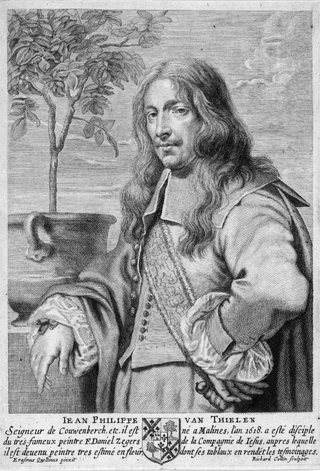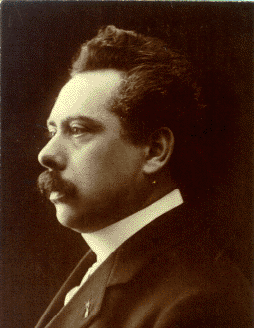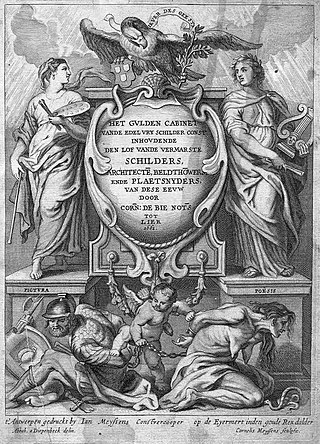
Jan Frans Willems was a Flemish writer and father of the Flemish movement.

Hendrick Jansz ter Brugghen was a Dutch painter of genre scenes and religious subjects. He was one of the Dutch followers of Caravaggio – the so-called Utrecht Caravaggisti. Along with Gerrit van Hondhorst and Dirck van Baburen, Ter Brugghen was one of the most important Dutch painters to have been influenced by Caravaggio.

Jan Snellinck or Jan Snellinck (I) (c. 1548 – 1 October 1638) was a Flemish painter, draughtsman and designer of tapestries, prints and frescoes. He is known for his large altarpieces and was also recognized as a leading battle painter in his time. Snellinck was active as an art dealer and art collector.

Jan Philip van Thielen or Jan Philips van Thielen was a Flemish painter who specialized in flower pieces and garland paintings. He was a regular collaborator with leading Flemish and Dutch figure painters of his time. Van Thielen was the most popular flower painter in Flanders and his patrons included Diego Felipez de Guzmán, 1st Marquis of Leganés and Leopold Wilhelm of Austria, the art-loving governor of the Southern Netherlands.

Cornelis de Bie was a Flemish rederijker, poet, jurist and minor politician from Lier. He is the author of about 64 works, mostly comedies. He is known internationally today for his biographical sketches of Flemish and Dutch painters in his Het Gulden Cabinet der Edel Vry Schilderconst, first printed in 1662.

Maurits Sabbe, born Maurice Charles Marie Guillaume Sabbe, was a Flemish man of letters and educator who became curator of the Plantin-Moretus Museum in Antwerp.

Het Gulden Cabinet vande Edel Vry Schilder-Const or The Golden Cabinet of the Noble Liberal Art of Painting is a book by the 17th-century Flemish notary and rederijker Cornelis de Bie published in Antwerp. Written in the Dutch language, it contains artist biographies and panegyrics with engraved portraits of 16th- and 17th-century artists, predominantly from the Habsburg Netherlands. The work is a very important source of information on the artists it describes. It formed the principal source of information for later art historians such as Arnold Houbraken and Jacob Campo Weyerman. It was published in 1662, although the work also mentions 1661 as date of publication.

Jan Baptist van Deynum, Dynen or Duinen (1620–1668), was a Flemish Baroque painter and a captain of the local civil guard in Antwerp. He is said to have painted portraits, genre subjects, history paintings and landscapes.
Diego Duarte or Jacob Duarte (1612–1691) was a 17th-century Portuguese jeweler, banker, composer, organist and art collector living in Antwerp, who owned paintings by Jan Vermeer, Raphael and others.

The Trippenhuis is a neoclassical canal mansion in the centre of Amsterdam. It was built in 1660–1662 for the wealthy Amsterdam weapons traders Louis and Hendrick Trip. Many references to weaponry can be seen on its facade. Since 1887 it has been the seat of the Royal Netherlands Academy of Arts and Sciences (KNAW).

Jan Michiel Ruyten or Jan Ruyten was a Belgian Romantic painter, draughtsman and engraver known for his genre paintings, cityscapes, landscapes with figures and history paintings. He was influenced by Dutch Romantic painting.

Nicolaas Rockox (1560–1640), was an art patron and collector, numismatist, humanist, philanthropist and mayor of Antwerp. He was a close personal friend and important patron of Peter Paul Rubens. His residence in Antwerp was a centre where Antwerp's humanists and artists congregated and housed a large collection of artworks, antiques, rare objects and coins. It is now a museum known as the Snijders&Rockox House. He was knighted by Archduke Albert and Isabella, the Governor General of the Habsurg Netherlands.

The Old Folks Sing, the Young Folks Chirp is a 1638–1640 oil on canvas painting by Jacob Jordaens, now in the Royal Museum of Fine Arts Antwerp. He painted several works with this title, a Dutch proverb – this is the earliest of them, whilst another is now in Valenciennes.

The Joiners' Guild Altarpiece is a altarpiece by Quentin Matsys, executed c. 1511, produced for the eponymous guild in the aftermath of its split from the Coopers' Guild in 1497. It is now in the Royal Museum of Fine Arts, Antwerp. It is sometimes also known as the Passion Altarpiece or the Martyrdom Altarpiece after the scenes of martyrdoms of John the Baptist and John the Evangelist on the side panels. Both these saints were patrons of carpenters and also appear in grisaille on the outside of the side panels. The central panel shows the Lamentation over the Dead Christ.
Calvary is a 1525-1549 copy of a lost work by Jan van Amstel, now in the Royal Museum of Fine Arts, Antwerp, to which it was bequeathed by Florent van Ertborn in 1849. At that time it was attributed to Pieter Aertsen, though it has later also been attributed to Frans Floris and Gillis Mostaert I.

The Prodigal Son is an unsigned 1618 painting by Peter Paul Rubens. It is now in the Royal Museum of Fine Arts, Antwerp as catalogue number 781 - the Museum bought it via the Paris-based art dealer Léon Gauchez in 1894. The work was examined during the 2007 Rubens research project

The Parisian Sphinx is an oil-on-canvas painting by Belgian painter Alfred Stevens. Painted between 1875 and 1877, it depicts a dreamy young woman gently supporting her head with her hand. The painting is part of the permanent collection of the Royal Museum of Fine Arts in Antwerp. The Parisian Sphinx shows the influence of Vermeer and the other Netherlandish old masters on Stevens, and testifies to the Symbolist influence in the latter's day. It incorporates a harmonious juxtaposition of superficial Dutch realism with the spreading Symbolist manner, as opposed to the bottom-up, pluralistic symbolism of the declining Romanticism.

Portrait of Stephan Geraedts, Husband of Isabella Coymans is an oil on canvas painting by Dutch Golden Age painter Frans Hals. The painting was originally part of a couple of pendant wedding portraits. Hals probably painted the present portrait, Stephanus Geraerdts', alderman in Haarlem, and the accompanying portrait of the latter's wife Isabella Coymans around 1650–1652, six or seven years after their marriage in 1644. Isabella's portrait is now in a private collection in Paris.

Self-Portrait is an oil-on-canvas painting by the French Neoclassical artist Jean-Auguste-Dominique Ingres. The painting measures 25.2 x 20.9 inches and is part of the permanent collection of the Royal Museum of Fine Arts in Antwerp. This painting is one of the last portraits by Ingres.

The Preacher Eleazar Swalmius is a 1637 oil-on-canvas painting by the Dutch artist Rembrandt. It is currently owned by the Royal Museum of Fine Arts in Antwerp. The painting has been certified a real Rembrandt. The painting was listed in 1727 in the catalog of the Duke of Orléans collection, as a portrait of an Amsterdam mayor by Rembrandt. It remained in the noble family's possession until 1792, when Duke Louis-Philippe-Joseph sold the entire collection to finance his political career and pay off debts. The painting passed through several English collections into the hands of the Bourgeois brothers, art dealers from Cologne, who sold the painting as an original Rembrandt to the museum in 1886. The painting was stored away for a long time due to doubts cast over its authenticity.


















